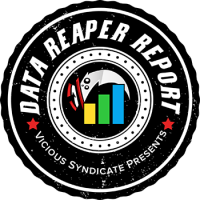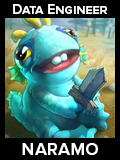
Welcome to the 137th edition of the Data Reaper Report! This is the first report for Saviors of Uldum.
Our Data Reaper Project, including the Data Reaper Live has 4,000 active contributors and we thank them wholeheartedly. Contributing to the Data Reaper project through Track-o-Bot or Hearthstone Deck Tracker (recommended) allows us to perform our analyses and to issue the weekly reports. Without the community’s contribution, there would be no project. Contributing data is very easy and takes a few simple steps, after which no other action is required. If you enjoy our content and would like to make sure it remains consistent and free – Sign Up!
Quick Links
Class/Archetype Distribution | Class Frequency | Matchup Winrates | vS Power Rankings | vS Meta Score | Class Analysis & Decklists | Meta Breaker of the Week | How to Contribute | Credits
Number of Games
| Overall | 70,000 |
| Legend | 4,000 |
| Ranks 1-4 | 18,000 |
| Ranks 5-9 | 33,000 |
| Ranks 10-14 | 12,000 |
Class/Archetype Distribution
[TABS_PRO id=23531]
Class Frequency
[TABS_PRO id=23533]
Data Collection Reminder
This has been a very quiet launch of an expansion in terms of number of games logged, so your data contributions are critical to keep this project going. It’s very easy to sign up, so please consider it if you can!
For current contributors, make sure your tracker is active while you’re playing. In the case of HDT contributors, make sure your plug-in is still enabled after the launch of the new expansion and subsequent patch.
Thank you!
Class Frequency Discussion
With the launch of Uldum, the player base is expectedly trying all the new decks and strategies that are promoted by the new set. Once we hit rank 4 and the ladder climb becomes more competitive, we can start seeing a metagame picture forming. We’ll focus on what’s happening at ranks 4-1, as well as legend, because that’s probably where the meta at lower ranks is headed to once the “jank” fades away.
Mage is the most popular class in the game, and there’s been an interesting trend developing within the class throughout the first week of Uldum. Initially, Big-Spell Mage was fairly common, but it was quickly eclipsed by Highlander Mage, which has become the most popular deck in the format. Cyclone Mage, which has added no new cards from the new expansion, has stayed relatively low due to the lack of interest in playing an “old” deck.
Warrior is the 2nd most influential class in the game, with Control Warrior becoming the premier archetype of the class after adding the taunt package to its build. Bomb Warrior has fallen off, since much like Cyclone Mage, it hasn’t really added any new exciting cards to its build. Thanks to Bloodsworn Mercenary, Aggro Warrior has taken off and is becoming noticeably more popular at higher levels of play, so it’s definitely a deck worth looking out for.
Hunter houses the 2nd Highlander deck that seems to have made a significant impact on the meta, with a large percentage of its builds centered on the secret package and Subject 9. The more standard Secret Hunter is dwarfed in comparison, while the “old” decks from Rise of Shadows (Midrange, Mech) exhibit a very modest presence. Note that we’ve renamed “Bomb Hunter” to the more intuitive name of “Mech Hunter” since the slower, Oblivitron Mech Hunter deck disappeared.
Paladin has had a surprisingly good week of Hearthstone after most of us expected it to flounder. The Tip the Scales/Prismatic Lens Murloc Paladin deck turned out to be very strong. Quest Paladin is also around, mostly to encourage Control Warrior players to delete their decks. Other experiments, including various Highlander Paladins, haven’t materialized.
Quest Shaman has received a lot of hype, and that hype has translated into one of the highest play rates in the game. Both RoS staples, Aggro Shaman and Murloc Shaman, see modest play. The former is receiving a bit more attention at legend.
The new thieving Quest Rogue is also one of the decks many players have tried out with the launch of the expansion, but the archetype is declining at higher levels of play, where it is surpassed by Aggro Rogue. Aggro Rogue is essentially RoS Party Rogue, which cuts Raiding Party and Preparation in favor of both Waggle Picks and Hooked Scimitars.
Completing the trifecta of hyped quest decks is Druid. Quest Druid might be the most erratic archetype in the game, with endless experimentation of different builds and possible win conditions. While all quest decks are likely far from being optimized, and it’s important to keep that in mind when evaluating their performance later, Quest Druid is a particular standout. Untapped Potential is an enticing foundation for a deck, but it seems that fitting a win condition on top of it has been difficult.
It looked like Warlock was about to enter another expansion with the motto of “Zoo or bust”, since late-game strategies of the class were predicted to fail. There are no surprises here. Warlock is all about Zoo and its new tools, while slower Warlock decks are trying to figure out how to climb from Tier 6 to Tier 5.
We end with Priest, the least popular class in the format. That is until you hit legend and find a population of Combo Priests growing at lightning pace, one that we can barely keep up with. With both Quest and Wall/Quest decks fading away, Combo Priest is gaining ground and surpassing other common meta decks one by one. What exactly is going on here?
[TABS_PRO id=23534]

[TABS_PRO id=23535]
vS Meta Score
[TABS_PRO id=23536]
vS Power Rankings Discussion
“You expected Warrior or Mage to be first in the Power Rankings? Too bad! It was me, Anduin!”
Simply put, Combo Priest is nuts. Its matchup spread is almost perfect and nearly no other deck seems capable of holding a significant edge against it. Even at the early stages of the expansion, it is already hinting at a steep learning curve by making noticeable, nearly daily improvements in several matchups. This deck looks like the real deal.
We will caution that Priest is very likely taking advantage of the fact that it has not been accounted for yet. Jank aside, the entire early Uldum meta is trying to beat Warrior and Mage, while Priest is left to do whatever it wants. Once players start considering Priest in their deck building and learn how to play against it better, we might see an effective response against this surefire meta breaker.
Warrior is hot on Priest’s heels and is one of the classes that seem capable of matching up well enough against it. The new Taunt Control Warrior is an extremely powerful deck, certainly an upgrade on its RoS iteration, that demolishes aggressive decks as well as any deck that doesn’t have a powerful late-game strategy that can contend with the Mad Genius. Aggro Warrior also looks very strong, boasting a very green matchup spread, and would comfortably sit at the #1 spot if not for its miserable matchup into Control Warrior.
It’s interesting to note that based on its low sample, Bomb Warrior is also very much a Tier 1 deck, but its performance is inferior to Control Warrior at the moment. This might be why it’s struggling to see play despite remaining quite effective against the field, as players aren’t tempted to switch from a proven performer such as Control Warrior. However, we definitely wouldn’t write off Bomb Warrior from making a return considering how strong it still is and the possibility of Control Warrior getting targeted harder.
As time went on, it became clear to us that Big-Spell Mage was a somewhat greedy deck that was vulnerable to being preyed upon by aggression, and was more easily targeted by the general hostility directed at Mage. Highlander Mage is proving to be more flexible and capable of overcoming that hostility. Reno and Zephrys add the unconventional and extremely powerful answers that are required to offset the inconsistent nature of a singleton deck. It’s no accident that this archetype is taking over, and it might be the premier Mage deck going forward.
And yes, we do think Highlander Mage might be a stronger deck in the current meta than Cyclone Mage. While Cyclone Mage is certainly strong based on our estimate, it has seen the field get stronger while it stayed the same. Cyclone Mage also runs into specific troubles facing the new Control Warrior builds that have more mass removal options now and contest the board more aggressively. It will be interesting to see how it adapts, should it make a comeback on ladder. Until it becomes a more popular deck though, it will be hard to gauge just how effective it can be.
While Combo Priest is certainly about to break the meta, Highlander Hunter is worthy of a mention as a potential meta breaker down the road. This deck holds a significant advantage against both Control Warrior and Highlander Mage, something that no other deck seems capable of doing, while exhibiting the strongest win rate against Combo Priest. That’s big. What keeps Highlander Hunter amongst the elite pack, rather than ahead of them, are its weaker matchups against aggressive decks.
Secret Hunter also holds similarly promising matchups, but looks like a watered-down version of Highlander Hunter. Brann and Zephrys are making a big impact on the class’ ability to contest the top decks in the format, while the latter offers an X factor in aggressive matchups: comeback potential that Hunter would normally not have.
Mech Hunter is still exhibiting a strong win rate, but is in danger of not being able to keep up with the top pack eventually. The biggest reason is that its previously strong Warrior matchup has flipped upside down. The new taunt package is making it very hard to hit the Warrior in the face and finish him off before he stabilizes. Once the poorly optimized decks of early Uldum go away, Mech Hunter may run into a more challenging field.
Murloc Paladin looks like the premier aggressive deck in the format and a serious litmus test for the current meta. If you’re not able to deal with a turn 5 Tip the Scales with AOE, you better pull ahead on the board before it happens. That’s what Murloc Paladin is currently demanding from opponents, and there are only a few that have the perfect response, which is why the deck is as strong as it looks.
Quest Paladin is following in the footsteps of RoS Mech Paladin, but it might even be more polarizing. The deck annihilates Control Warrior and gives Hunters serious problems, but is a sitting duck to Mage, Priest, and aggressive decks. Considering its particularly horrendous performance against the rising Combo Priest, we’re skeptic whether it can keep its head above the Tier 3 waters for long.
At the moment, Quest decks are failing. Rogue, Druid, and Shaman all sit in Tier 4. There are two main reasons for this:
Quest decks have been generally harder to optimize. Even now, most builds of these archetypes currently seen on ladder aren’t the best they can be. We think that certainly has some impact on how they’re performing. Building the new Control Warrior took one day, for example. They just aren’t at the same refinement stage as the top meta decks.
While quest decks have pretty strong late-game potential, it’s still inferior to the late game available to Warrior and Mage. The power and inevitability of Dr. Boom and Luna’s Pocket Galaxy/Conjurer’s Calling is overwhelming, and most of these decks’ biggest issue is finding a way to not get rolled over by Warrior or Mage. We think they can definitely do better against these classes than the stats currently suggest (as well as Priest, which is currently also stomping quest decks), but the extent of the improvements they make may not be enough drag them out of where they currently are.
On a positive note, both Rogue and Shaman have strong non-quest decks that are very competitive and viable on ladder. Aggro Rogue is a strong performer that unfortunately happens to be hard countered by Warrior. Based on our low sample estimate, Aggro Shaman is a strong performer that unfortunately happens to be hard countered by Warrior. Thankfully, there is a simple solution for these decks to overcome this problem. Just don’t queue into Warrior. Easy.
Is Zoo Warlock a stronger deck in this expansion? It seems so, but Zoo Warlock notoriously declines in its performance when the meta begins to refine and settle, so its current win rate doesn’t guarantee that it can survive the next developments in the meta. Its matchups into Warrior, Mage, and Priest certainly do not bode well for its future in a more ruthless meta. We’ll have to see whether further refinements in Zoo can be fruitful, since we believe it’s actually a pretty hard deck to optimize right now.
Class Analysis & Decklists
Druid | Hunter | Mage | Paladin | Priest | Rogue | Shaman | Warlock | Warrior
The early frontrunner of Saviors of Uldum is Mage. It has become the most popular class at higher levels of play, taking advantage of new high-cost spell synergies that were introduced in this set.
Luna’s Pocket Galaxy might compete with Dr. Boom as the most powerful standalone card in the format. While this card has already seen play in Cyclone Mage, its performance in heavier control shells is far stronger and gives us vibes of Barnes in how it completely blows out the game. Mage’s ability to continuously cheat mana is unmatched by any other class in the game. While the list of mana-cheating tools at its disposal is long, Luna’s Pocket Galaxy and Conjurer’s Calling are at its top.
Initially, Apxvoid built a Big-Spell Mage deck that maximizes Mage’s biggest strength in the format: Mountain Giant, Conjurer’s Calling, Luna’s Pocket Galaxy, Tortollan Pilgrim, Kalecgos, and King Phaoris. All of these cards are strong performers that, based on our analysis, form the core of Mage’s late-game strategy. They are supplemented by high-value spells, including Puzzle Box of Yogg-Saron, which provides the deck with exceptional comeback potential. In order to survive, the deck runs the Freeze Mage package and defensive 4-drops to bridge into the Galaxy turn. Arcane Keysmith is particularly strong now that Flame Ward is an option to discover. Naga Sand Witch is a trap card.
However, after some time and experimentation, Highlander Mage has proven to be the stronger Mage performer. Many of Mage’s highest impact cards are 1-of’s, and while losing a Giant/CC pairing hurts, the addition of Reno and Zephrys is massive and makes for better matchups across the board. Reno provides a ridiculous tempo swing, and he was likely underestimated in card reviews.
When looking into card choices in Highlander Mage, we’ve found tutors to be very strong. When we’re playing a singleton deck, finding a way to draw our payoff cards more consistently is important. Sandbinder can draw us our Giant, Zephrys or Siamat. Witchwood Piper will often draw us Zephrys before Galaxy is played, or a big threat after Galaxy is played. If you haven’t noticed by now, we really want to draw Zephrys. A consistent Highlander deck is a dangerous one.
Cyclone Mage isn’t very popular on ladder partly because it hasn’t received any interesting new cards. The deck is still good, and seems to be performing well in tournaments too, but we do believe that Highlander Mage could be the superior choice overall. Cyclone Mage may struggle to gain a meaningful edge against the new Warrior builds, and that could hurt its chances of seeing more play over the more flexible rival within its class.
To the surprise of absolutely no one, Warrior remains one of the strongest classes, if not the strongest, in Saviors of Uldum. While Warrior did get some nice new cards, the untouched Mad Genius is where much of its power lies. Every deck in the game has to account for the strongest late-game card in the format and for the seemingly endless removal tools at Warrior’s disposal.
Control Warrior has emerged as the top archetype within the class, successfully adding the Taunt package into its build. Frightened Flunky is an exceptionally good card by itself, while Armagedillo and Tomb Warden are a frightening combination, offering both protection, as well as lines of aggression. Restless Mummy adds a strong rush minion to the Town Crier package, while Plague of Wrath strengthens Warrior’s removal options even more.
When looking at the most common Control Warrior build, initially popularized by Theo, it’s hard to make significant improvements, but we will provide some important insights. It’s very likely better to run at least 3 rush minions at the 4 mana slot. It’s less important whether we run two Mummies or two Commanders, but Town Crier is a better card when it draws a 4-drop on turn 1 (rather than Zilliax), and both 4-drops available to Warrior are of similar power levels.
We also noticed that Dyn-o-matic has grown weaker in this expansion. This is likely a result of both meta changes (such as the decline of Rogue) as well as changes within Warrior’s playstyle (the deck is less passive in the early game thanks to Flunky). We don’t consider Dyn-o-matic to be a core card at the moment, so don’t be afraid to flex it out. Finally, Plague of Wrath’s success depends on the presence of Mage and Priest, so it’s a worthwhile inclusion today, but may fluctuate in its performance in the future.
Bomb Warrior has had a much quieter presence since the expansion launched, and is a bit overshadowed by Control Warrior and its new tools. Another likely reason we don’t see many Bomb Warriors on ladder anymore is that the new Taunt package in Control Warrior can very effectively negate Bomb Warrior’s aggression in the mirror matchup. Control Warrior used to run just 1 taunt minion (Zilliax), so it was actually quite vulnerable to being smacked in the head. With Frightened Flunky and Tomb Wardens, it’s much harder now to deliver the minion damage required to make the Bomb damage matter, before you’re out-valued.
Aggro Warrior looks like an extremely promising archetype that was elevated to relevance thanks to the sheer power level of Bloodsworn Mercenary and Livewire Lance. Mercenary’s success isn’t very surprising, but Lance’s prospects of being the strongest card in the deck is eye-opening.
Aggro Warrior’s matchup spread is pretty ridiculous. It can beat any deck in the game… except for Control Warrior. This one oppressive matchup is keeping it from the very top of the meta. In terms of card choices, we think there’s room for improvement, with several underplayed cards observed. Arcanite Reaper provides reach to finish off games, and we consider it to be core since this deck loves immediate damage from hand through charge minions and weapons. Redband Wasp is criminally ignored, as it’s actually our best 2-drop outside of Flunky, and is made better by the tutoring effect of Town Crier. It’s very important to be able to set up a turn 3 Mercenary consistently, and running Redband Wasp over Amani Berseker increases the odds of that occurring by roughly 25%.
Upgrade and Greenskin are decent cards to run with Lance and Reaper but are a bit too cute and hard to fit over stronger cards. Battle Rage is generally overrated because we don’t want the game to go on too long, so a situational draw effect isn’t very strong. Think of this deck as a Pirate Warrior with some combo set-up in the early game, and you’ll understand where we’re coming from. We go face.
Hunter has had a good first week of Uldum. It usually starts strong, but even the most optimistic of Hunter players may not have expected Highlander Hunter to be this good. The archetype performs well against most of the top-performing meta decks, putting it in an elite position going forward. It’s the only deck that has a positive win rate against both Warriors and Mages, and it’s also the only deck that seems capable of holding a significant edge against Priest.
Of course, Highlander Hunter does have a weakness, which is faster matchups such as Murloc Paladin and Zoo Warlock. Nevertheless, its matchup spread is still pretty impressive and makes it one of the best decks in the format.
It’s a bit surprising that while Highlander Hunter is so impressive, Secret Hunter looks inferior in every way (while still being a decent ladder deck). There are three main reasons for this:
- Both decks can run the same number of Zul’jins and Subject 9’s. These cards encourage the utilization of singleton secrets regardless of a deck-building restriction. In terms of big power plays, Secret Hunter doesn’t run more of them.
- Dinotamer Brann is an extremely powerful threat that curves perfectly into Garrosh’s most vulnerable turn: when he wants to morph into Dr. Boom and before he can activate Omega Devastators.
- Zephrys provides Hunter with answers to situations the class would never have access to otherwise. Hunter’s toolkit is limited in its ability to fend off aggression, and it’s also limited in its response to power spikes by other late-game strategies. Zephrys plugs this gap perfectly and makes up for the fact Highlander Hunter’s curve is less consistent, while also serving as a win condition by himself.
Beyond its two Secret archetypes, Mech Hunter and Midrange Hunter can be observed. Mech Hunter hasn’t received any new cards, but still performs quite well. Midrange Hunter added Scarlet Webweaver to enable big Tundra Rhino combo’s, as well as Desert Spear, but the archetype has fallen off the map and currently looks very poorly positioned.
Will Shaman remain the middle class? It certainly seems so initially. The class is able to field a few competitive decks, but ones that are shy of the power levels observed in the top classes in the format.
Quest Shaman has been the most popular Shaman archetype, spurred by the potential of Corrupt the Waters. However, it has struggled to find an optimal build that balances between the late game prowess necessary to beat Warrior and Mage, and the defensive/tempo tools required to fend off aggression. One card we feel is a bit of a sleeper is Abusive Sergeant. It’s a versatile card that can produce a significant amount of damage, working well with Shaman’s burn plan through Wasps and Lifedrinkers, and it can act as a strong board control tool by enabling favorable trades.
What’s interesting to note about Quest Shaman is how poorly expensive cards perform in the deck. You’d think it would be the perfect home for Swampqueen Hagatha, Siamat, Barista Lynchen, and Giggling Inventor. However, they are all too slow, with only Shudderwock proving to be worthwhile. The jaws still bite.
For now, the more aggressive Shaman decks look like stronger choices on ladder.
Aggro Overload Shaman is trending towards swapping the burst of Doomhammer/Rockbiter/Lava Burst in order to run a more token-centric Bloodlust build, incorporating Mogu Fleshshaper, Soul of the Murloc and Vessina. Vessina is completely nuts and heavily promotes this direction (though we wouldn’t rule out Doomhammer builds just yet). A card that’s surprisingly underwhelming in this deck is Sandstorm Elemental, likely due to its redundancy with Thunderhead, which is a much stronger card that takes away the need for a small AOE clear. There is one slot we’re unsure about, which is currently occupied by Hex (Spirit of the Frog synergy, good against both Mage and Priest).
Murloc Shaman has been boosted by the addition of Murmy and Fishflinger. These early-game murlocs improve the consistency at which a Murloc Tidecaller can snowball, and have good stats for their cost. With a heavier focus on the early game, we’ve seen the normal top end of the two Hagatha’s and Shudderwock be removed. There are two reasons for this:
This top end has become less effective against Warrior than it used to be due to the addition of the taunt package. You’re much more likely to fall behind on board against Warrior in the late game, making these value engines less meaningful to keep you going. If you have no board, it’s that much harder to get it back with Tomb Wardens facing you down.
This top-end does nothing against Mages. These days it’s far more important to snowball early against Mage (as well as Warrior) than it is to acquire resources on turns 8-9. If they played Galaxy on 5 and you haven’t killed them, you’re already dead by the point you can play Hagatha or Shudderwock.
Through disappointments and surprises, Paladin has found some relevance in Saviors of Uldum. It might not be one of the most well-rounded classes, but it’s competitive enough to make an impact in the current meta.
The theorycrafted Tip the Scales Murloc Paladin deck was not just a good meme. It has birthed a very good deck. Prismatic Lens allows the Paladin to completely blow out opponents as early as turn 5, forcing them to have the AOE necessary to deal with the onslaught of murlocs… or hover to the bottom right corner of their screens. Aggressive decks have to stay ahead before Tip the Scales happens, or find themselves in a completely hopeless situation. If you ever happen to survive two Tip the Scales, a Chef Nomi and Zephrys are waiting to finish things off. Only the decks that sit at the top of meta seem capable of consistently dealing with Murloc Paladin.
Quest Paladin has also surprised us by being the best performing quest deck during the first week of Uldum. We’re pretty sure no one called this, but unlike the other quest decks, this one was very simple and straightforward to build, which helped it get off to a strong start. Quest Paladin is an extremely polarizing deck, even more so than the Mech Paladin of Rise of Shadows. It completely dumpsters Warrior, and gets equally dumpstered by Priest, which are the two most extreme matchups we can observe. We have serious doubts on whether this archetype can actually last in the upcoming meta, but if you want to make Warrior players suffer, you queue up this monster.
Other Paladin decks have been disappointing. Big Paladin remains a meme we can’t recommend playing on ladder, while Highlander Paladin might be the worst Highlander deck of the four explorer classes. Poor Finley’s only role in the current meta is to serve as a River Crocolisk in Murloc Paladin.
Rogue has certainly lost some ground in this expansion, at least on the first week. Part of it is because other classes have gotten stronger, but it’s also because it’s lagging behind in terms of refinement compared to other classes.
Quest Rogue looks statistically weak, but most common builds are plagued with cards we can tell are straight-up terrible, so in this section we will float new ideas that can give the archetype a better chance of seeing consistent success. Quest Rogue’s problem is that common builds don’t have a clear and consistent win condition that can provide inevitability in the Warrior and Mage matchups, so they often get blown out by these classes’ power spikes.
J_Alexander created a build with a promising combo, which is running Togwaggle’s Scheme to cast on Tess Greymane and have endless board reloads against Warrior. An idea that may help Scheme become a more consistent card is running Togwaggle alongside Greymane. We generally struggle to justify excluding Togwaggle from a Rogue deck that wants a late-game plan anyway. Togwaggle does a good job at increasing the likelihood we draw Greymane on time through Wonderous Wand, while also offering an alternative Scheme target in the case she doesn’t show.
As for quest progression, Pilfer has proven to be so weak that we think it’s best to remove it altogether since it baits us to keep a bad card in the mulligan. What we found to be somewhat surprising is how relatively well Brightwing and Face Collector perform as Quest enablers, together with providing fuel for Tess Greymane. A cheaper alternative to them would be Pick Pocket, which serves as a stronger quest closer than Pilfer that scales better in the late game.
The more proven performer within the class at the moment is Aggro Rogue. Basically, as we’ve suggested in our theorycrafting article, we take the Raiding Party out of Party Rogue and run 4 weapons to enable free Dread Corsairs. One notable tech card we’ve seen in the deck from BoarControl is Zephrys, which acts as a 2 mana 3/2 that occasionally gives us the perfect card to find lethal post-MUE. Unlike Nomi, Zephrys doesn’t come with a big deck building cost, so don’t let him rot in your hand if MUE isn’t there. Other cards we see in the deck are Faerie Dragons and Hench-Clan Thugs. Both are very good against Mage, but are weak against Warrior, a matchup in which you’d rather have Deadly Poisons/SN1P-SN4P.
After spending most of Rise of Shadows in the gutter, Priest is primed for a massive turnaround in its fortunes. With Warrior and Mage seemingly dominating the meta, Combo Priest is the one that might take the throne of the actual best deck in the game.
Combo Priest’s most crucial breakthrough originated in the Data Reaper’s own lab. After being alerted with the potential of Quest-less Combo Priest by Alice and Tubu, ZachO tweaked the original build to include Lightwardens and Holy Ripples. Holy Ripple has proven to be a good performer, especially in faster matchups, but the addition of Lightwarden was the big game-changer for the archetype. It serves as a proactive 1-drop that can snowball, a threatening Extra Arms target, and a Frothing Berserker-esque win condition later in the game that becomes particularly oppressive with Amet. Once the featured build has spread through Twitter and Lightwarden was widely adopted, we could see the needle of Combo Priest’s win-rate skyrocket.
Today, Combo Priest looks like a deck with nearly no weaknesses, with a meta breaking matchup spread. It can beat any deck in the game, and its performance at higher levels of play already suggests an extremely high skill cap. While the deck has a strong curve of minions and can blow out opponents early, its management of resources can be quite difficult to navigate and you will often run into very complex turns that revolve around Lightwarden, Cleric and Wild Pyromancer.
In terms of builds, we don’t see a major reason to move away from the current build on ladder. Silence effects are generally overrated, and Mass Dispel is run in order to ensure we can land a killing blow through multiple taunts (such as Tomb Wardens). Holy Ripple is an incredible card against Shaman, Warlocks and Paladins, since it boosts Wild Pyromancer’s ability to clear a wide board. We would only consider cutting it if you’re running into nothing but Warriors and Mages. Meati has had top legend success with a build running Loot Hoarders and Madam Lazul over Mass Dispel/Holy Ripples, which is a hard shift towards the Warrior matchup.
Other Priest decks haven’t shown much promise. The Priest quest looks like a bait, and Wall Priest has fallen deep inside that rabbit hole, completely adopting it without making it look worthwhile at all.
Druid had a rough week trying to figure out what it wants to do. While the foundation of Untapped Potential continues to show promise, it’s been difficult to find the best win condition to slap on top of it. It looks like just Choose One “good stuff” may not be enough for Quest Druid to pull through, and it needs a more specialized goal to aim towards.
There are two main win conditions we’ve identified that show some promise, and they can be accommodated in the same shell that can swap between them. The first win condition is Malygos, and the second is Nomi/Phaoris. Both require Elise if you’re interested in beating Warrior with consistency.
The Malygos win condition runs Malygos, Dreampetal Florist and Moonfire. Ideally, we discount Malygos, copy it with Elise and produce a lot of damage through multiple Floops and Moonfires. The execution of this combo can be difficult due to hand space issues, which is why Overflow is an awkward card to include in the build. The advantage is we don’t care about freezes since our damage bypasses the board.
The Nomi win condition runs Chef Nomi, Cenarius and Phaoris. We can play Phaoris and Cenarius earlier in order to bait removal and fall back to copying Nomi and Floop with Elise as we approach the end of our deck. One Elise being played means we can have 4 Nomi’s in our hand (Nomix2, Floopx2), and we can copy more if our hand space allows it (though it’s probably unnecessary). This win condition is easier to execute and also has a faster plan in other matchups through Phaoris and/or Cenarius, followed up by a Floop. This win condition is also far better against Warrior since our threat potential is near infinite and we don’t need to worry about running out of damage. We generally recommend the Nomi build on ladder.
As far as our choices when it comes to the Combo Quest Druid shell, it’s all about card draw, removal and hand manipulation. We need card draw to get to our combo pieces. We need removal to survive. We need a way to easily dump cards from our hand to make it easier to copy our combo pieces with Elise. That’s why both Innervate and Pounce are very good cards in the deck.
Players haven’t been very excited to play Token Druid, but the archetype isn’t a lost cause in the current meta. We’re intrigued by running an Overflow build that takes advantage of Garden Gnomes, Mulchmunchers, and Anubisath Defenders. This build plays out similarly to the Token Druid of Boomsday rather than the aggressive build we’ve normally seen throughout Rise of Shadows, patiently setting up big turns rather than going for the throat early.
The fears that Warlock may have to rely on the Zoo archetype in order to find relevance in the Uldum meta appear to be coming true. With Quest Warlock predictably falling flat and no late game strategies looking to be remotely viable at the moment, the aggressive archetype is all Gul’dan has. Until Warlock receives a reliable form of healing, it will likely struggle to survive long games and Life Tap itself to death. But even when Warlock is able to survive into the late game in the current meta, its win conditions are pathetic compared to the power plays other classes are capable of. We’ve observed all sorts of Plot Twist decks, including ones that run Mecha’thun as a finisher, but all of them are strictly Tier 5 decks, and that’s a generous assessment.
Zoo Warlock does appear to be competitive, but building it is quite challenging since it has several power cards that need sizeable support to work well. EVIL Recruiter is incredible when fully supported by the lackey package, but gets worse if we start cutting any lackey generators. EVIL Genius continues to be a terrific lackey generator, but needs good sacking targets to truly come online. Magic Carpet works well with lackeys, but needs a decent number of 1-drops alongside them. Diseased Vulture/Neferset Thrasher is another pair that demands to be fit in.
So, we tried to incorporate all of these powerful cards into one list. The conclusion is that Knife Juggler and Dire Wolf Alpha, which don’t perform particularly well at the moment, have to go. Serpent Egg is superior to Scarab Egg, especially when we don’t run Sea Giants (which get worse in a Mage/Warrior meta). We think this featured build is an upgrade to common ladder lists, though things will likely change as the meta develops further.
Combo Priest is the big story of the week, and it’s about to substantially re-shape the landscape, especially at higher levels of play. As a deck with seemingly no glaring weaknesses, it’s hard to argue against it being the best deck of the first week of Uldum. Combo Priest is very cheap to craft, but ironically it’s not a great fit for new players, since it’s extremely difficult to play well and can be often overwhelmingly complex even for the best players on ladder.
If you’re looking for a smart meta read, and want to stay one step ahead of everyone, Highlander Hunter is a great choice. With all the hype surrounding Mage, Warrior and now Priest, Highlander Hunter is an elite deck that is well-positioned against all three.
We’ll see you again next week, where a different meta, a Priest meta awaits us.
Our Data Reaper Project, including the Data Reaper Live has 4,000 active contributors. Without them, this project would not be possible, so we’d like to thank all of our contributors for their help.
Preparing our weekly article requires a significant amount of time and effort from many individuals. We would like to wholeheartedly thank our current Patreons, whose generous donations help us fund computing and server costs.
vS Gold is a new membership plan aimed to support our efforts towards improving our content and data analysis while receiving some bonuses and extra features.
Tier 3+ Patrons
Special thanks to Leo G, Aaron B, Jed M, Drew M, Alan J, Eric L, Zolstar, Sean H, Steve F, Andrew N, NObdy, Mark S, Alonso P, msKang, James Y, PinkMageDiaries, Je-ho, Ziqiao Y, Stephen H, William H, and Patrick L for supporting us for the month of August.
Contributors
Here are all the people that participated in bringing you this edition of the vS Data Reaper Report:






























@dayarra well, if a card you play only when you don’t have any other choice or you lose, has 42% winrate, it means it’s pretty insane no ? If you go from 0% to almost 50% with it
@dayarra: I’d say it’s more a fun card than a win condition card. I mean it’s random, right? It’s like you said, it has some comeback potential, but that’s pretty much it. You don’t want to play it when you got board control. Therefore I’d never play that card for climbing the ladder.
Anyway I’m glad to see Highlander Hunter doing that well. For the first time I picked a good deck to play after an expansion release that won’t be bad after a short time (that’s what I hope at least). I definitely enjoy it much more than Mech Hunter, which was quite good but not fun to play IMO. Highlander Hunter isn’t easy though, it takes some time to get used to it. And Zephrys is such a great card! It gave me lethal so many times. 🙂
what do you guys think about puzzle box? is it really a good card? i often find it not worth to play. yes it gives a comeback chance but does it really worth it? some stats say it has a 42% played win rate, which is not too bad i guess considering you play it at already bad situations, what do you guys have on this card?
No mention of mech highlander hunter?
I guess the sample is just too small for now.
Good to see the reports back! Great insights, but I think you guys are over-rating quest Paladin v warrior. I’ve tempoed out the qpalas often enough that the matchup doesn’t feel too unfavorable, and on one occasion I even fatigued them
Druid is seeing so much experimentation in legend right now, I’m optimistic it will find a home. I think one variation that is being slept on is a full Highlander Druid. The main issues with the Maly/Nomi Druid is that you don’t have the ability to deal with certain large board states while working towards your draw & combo, fast decks can beat you before you even have a chance, and you usually need a turn off when you go for the dreampetal florist turn. Zephrys seems to provide a solution for these problems if it can be consistently active at all stages of the game, plus Druid has the benefit of being able to copy Zephrys with floop or elise against fast decks where you don’t need to really pull off the full combo to win.
The main problem though, is this is a super difficult list to optimize as Druid doesn’t have a lot of good cards that you can slot in in a full highlander version, especially since you’re playing the game a turn behind with the quest, and you won’t be able to run 2 copies of your best cards in Surger and Starfall. I wonder if a highlander strategy which cut the quest entirely and relied on the grizzly package or RoS packages (still running surger of course) might actually be more effective, so you don’t take as much of a tempo hit or have to run garbage like Pounce and Zephrys can help you stall out the RoS Maly druid’s tougher late game turns where you were out of Grizzly’s etc…
Excited for the experimentation to continue though and great work with this report!
How core would you say Phaoris is in Reno Mage? I’ve already crafted a bunch of legendaries and he doesn’t seem like a particularly juicy craft to spend my limited remaining dust on.
I’m sad you didn’t touch on Highlander tempo warrior this week, was really looking forward to your trimmed down version and analysis of the deck. Maybe next week? Eh 😉